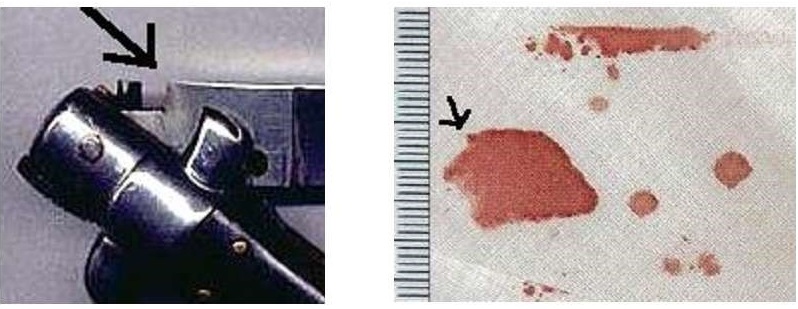The truth about the knife
Raffaele's kitchen knife was the prosecution's "smoking gun." The knife was reported throughout the world as "the double DNA knife." The prosecution claimed that Amanda's DNA was on the handle and Meredith's DNA was on the blade. That is pretty damning evidence. Well, it would be if it was true. But the truth is, Raffaele's kitchen knife was never used in any crime. The prosecution never found the murder weapon that was used to kill Meredith Kercher.
The knife was a common kitchen knife retrieved from the kitchen of Raffaele Sollecito. The knife was chosen from the drawer because it looked clean. No other knives were taken to be tested. Was this an extraordinary case of good luck by the detectives or was this knife not the murder weapon after all?
Italian forensic police expert Patrizia Stefanoni performed the DNA testing on the knife. When the knife was tested, Amanda's DNA was found on the handle. This was expected because Amanda often prepared meals at Raffaele's apartment. She used the knife for cooking.
A sample was taken from the knife blade and was tested for blood. The result was negative. There was no blood on the knife. This needs to be repeated,
THERE WAS NO BLOOD ON THE KNIFE.
What was left of the sample from the blade was tested for DNA.. The results were negative.There was no DNA on the blade. This is when all guidelines for testing DNA were thrown out the window. Stefanoni used a very new, unproven technique called low copy number DNA profiling.
Patrizia Stefanoni had neither the proper equipment nor the proper laboratory to perform low copy number DNA profiling, but she did it anyway. There are only a few such laboratories in the world. Her own lab was not even certified to perform ordinary DNA profiling at the time these tests were performed. Stefanoni performed tests that do not conform to any standard, anywhere.
Even with the low copy number method, Stefanoni was still not getting the desired result. The tests kept coming back "too low." She took even more drastic measures. The machine parameters were over-ridden. The machine parameters were pushed far past the level of reliability finally producing the result she needed. Keep in mind, the test was done in a lab using large amounts of Meredith's DNA. No negative controls were used. The alleged match to Meredith’s DNA is completely unreliable because the result was so infinitesimally small (less than 100 picograms, with a picogram being a trillionth of a gram, or 0.000000000001 gram). The procedures used to get the result Stefanoni needed were deeply flawed. The DNA found on the knife came from the lab. The knife had no DNA from Meredith Kercher on the blade when it arrived for testing. The DNA sample was so small that only one test could be performed. No additional testing will ever be available.
Keep in mind,
No blood was on the blade.
The knife doesn't match the wounds on Meredith.
The knife doesn't match the bloody imprint left on the bed.
No control tests were done to eliminate the possibility of contamination in Stefanoni's lab. A lab that had tested large amounts of Meredith's DNA. A spoon from Raffaele's kitchen would have most likely provided the same result in that environment using the standards that Stefanoni applied.
Mark C. Waterbury, Ph.D, summed up the lack of control testing perfectly:
"Perhaps even more important for the knife DNA, no control experiments were run to follow the handling of the item from the field through to the laboratory. That is, to see if other, random objects retrieved from the same drawer and handled in the same, unprofessional way, might also appear to have DNA on them. It would be interesting to hear the prosecution spinning a sinister implication out of DNA found on a can opener. Perhaps one can use canned peas for satanic rituals. Would Meredith's DNA be found on a spoon from the same drawer? How about Filomena's? Would the spoon then be cast as the murder weapon, whether it matches any wounds or not?
All this is preposterous of course. But think about it. We have no way of knowing what the supposed knife DNA means, or where it came from, because no comparison tests of any kind were performed."
The knife in question was not the murder weapon. The knife in question had nothing to do with Meredith's murder. The prosecution never found the murder weapon.
Let's stop and think about this. One of the officers that testified at the trial said he used "police intuition" when choosing the knife from Raffaele's drawer. Officers testified that there was a strong smell of bleach in the apartment and that the knife had looked exceptionally clean. Italian forensic police expert Patrizia Stefanoni testified that it had tiny scratches on the side, compatible with intense scrubbing. Take a note on the "intense scrubbing" description. I will come back to that later. The image below was taken from the actual police video. The officer chose to take only one knife. There was at least one other knife in the drawer. The other knife in the drawer could simply be a bread knife or it could be a slanted edge serrated knife or a fork tip serrated knife. The image is not very clear. Unfortunately the police did not take any photographs of the kitchen so we have to rely on the video images. The officer did not think to take the other knife in the drawer or any other knives in the kitchen for testing. Neither one of the knives in the drawer looked like a murder weapon so why not test both? He simply knew from his "police intuition" that he had the murder weapon. He didn't need to collect any other knives for testing. Does this sound reasonable to you?
Take a look at your knives at home. Unless your utensils are fairly new, you will see small scratches, nicks and blemishes all over your utensils. This is typical wear from normal use. Dishwashers and hand washing will leave small scratches on silverware and glassware. The knife in question had some scratches on the blade. This is hardly proof that it was subjected to intense scrubbing. Most likely the knife had been washed in a dishwasher or hand washed a few times, nothing more.
Officers testified that there was a strong smell of bleach in the apartment. Some used this to insinuate that the apartment as well as the knife had been cleaned with bleach. No bleach was ever found on the knife. As far as the smell in the apartment, Raffaele had a maid. The "smell of bleach" in Raffaele's apartment turned out to be merely a "clean smell," not surprising since his maid had cleaned the apartment thoroughly on Nov. 5 with Lysoform, which has a very strong smell. The prosecution produced no test that proved the house had been bleached. Lysoform actually contains no bleach. The police simply smelled a recently cleaned apartment.
Luminol testing in Raffaele's apartment revealed no evidence of any clean up. No evidence of any kind was found in Raffaele's apartment. We are supposed to believe that the knife was taken from Raffaele's kitchen, used to kill Meredith, then returned back to Raffaele's apartment. There was no blood transfer of any kind found in Raffaele's apartment from the knife. We are supposed to believe that a bloody knife was cleaned and returned to the drawer without leaving one single trace of DNA anywhere in the apartment. Does this sound reasonable to you?
The prosecution had to change their original theory that the kitchen knife was the only weapon used to kill Meredith when it was shown that the knife was too large to cause most of Meredith's wounds. The knife was also too large to match a bloody imprint left on the bed. When this information became available, they simply stated that two knives must have been used. They provided no additional evidence.
Where is the knife that matches the blood stain found on the bed? According to the prosecution, Amanda and Raffaele took great care in cleaning the larger knife and returning it to Raffaele's kitchen. Where is the smaller knife?
The smaller knife that made the imprint on the bed is the correct size blade that would be compatible with all of Meredith's wounds. Meredith Kercher was murdered with one knife. The knife that was used to murder Meredith was never found.
After reading the observations on this page, do you still have confidence in Patrizia Stefanoni's analysis of the knife? Here is one more observation to consider. Stefanoni testified that it had tiny scratches on the side, compatible with "intense scrubbing." Stefanoni also implied that the knife was scrubbed with bleach. Keep in mind, bleach is excellent at destroying DNA. In fact, it is used in forensic laboratories to sanitize work areas. So if you chose to believe what Stefanoni stated in the trial regarding the knife being subjected to "intense scrubbing" with bleach, how on earth was "touch" DNA from Meredith found on the surface of the blade?
Elizabeth A. Johnson, Ph.D, appeared on Good Morning America. She made this statement in reference to the lab detecting no blood on the knife but still somehow being able to detect Meredith's DNA:
“If someone had a knife covered in blood and they tried to clean it very well, they would remove their ability to detect the DNA before they removed the ability to detect the chemical traces of blood.” Therefore, the lack of blood makes it impossible for there to be DNA on the knife, so the DNA that was observed has to arise from contamination."
Whether you chose to believe the observations on this page or the testimony of Patrizia Stefanoni, one thing is certain, the knife wasn't the knife. The prosecution never found the murder weapon.
Why would Patrizia Stefanoni try so hard to get the desired result for the prosecution? Because she needed to deliver the expected results to her boss, Dr. Renato Biondo. Biondo was not only the head of the DNA Unit at Polizia Scientifica, Rome, he was also a consultant for the prosecution. I'm not making this up. This is how ridiculous this case is. Even more ridiculous, the defense asked for an independent review of the DNA results and their request was denied.
Please click on the links below to read more about low copy or "touch" DNA.
Click Here to view the letter from Elizabeth A. Johnson, Ph.D. and Greg Hampikian, Ph.D. Elizabeth A. Johnson is a Forensic Biology and DNA expert. Greg Hampikian is the Professor and Director of the Idaho Innocence Project Department of Biology Boise State University.
The photographic evidence shows that Raffaele's kitchen knife is to large to match the bloody imprint on the bed

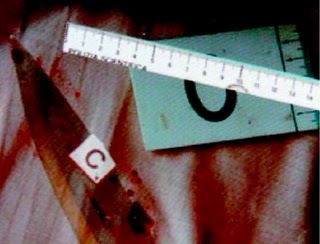

Notes:
low copy DNA profiling: http://www.sciencespheres.com/
The links above provide excellent information in regard to low copy number DNA. You can read more about DNA profiling here:
The smaller knife that made the imprint on the bed is the correct size blade that would be compatible with all of Meredith's wounds. The wrong size knife was taken from the drawer by the police officer. This caused problems for the prosecution when it was proven that the knife was too big. Instead of correctly eliminating the big knife, the prosecution simply changed their theory and stated that two knives must have been used. Meredith Kercher was murdered with one knife. The knife that was used to murder Meredith was never found.
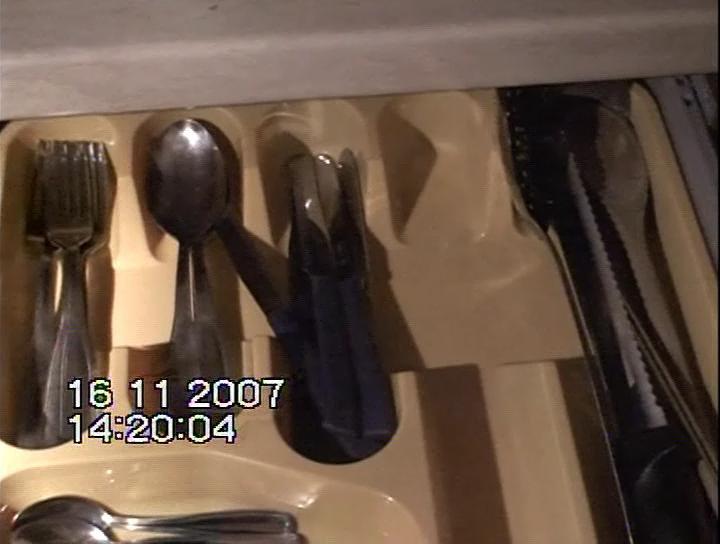
Update 2013: During the 2013 appeal, Judge Alessandro Nencini ordered new testing on a sample previously taken from the knife by Stefano Conti and Carla Vecchiotti. That test produced a negative result for Meredith, and a positive result from Amanda. Meaning that no new information was gained from the additional test. As you will read below, It was already known that Amanda's DNA was present due to the fact that she used the knife for cooking.
Update 2011: Court appointed independent forensic experts, Stefano Conti and Carla Vecchiotti, from Rome's Sapienza University, testified on appeal detailing gross negligence on the part of lead forensic scientist, Patricia Stefanoni. This testimony fully discredited the alleged murder weapon and the DNA laced bra clasp. Click here for full details

Injustice in Perugia
a website detailing the wrongful conviction of Amanda Knox & Raffaele Sollecito

The Truth About The Knife
Additional Resources
Professional Analysis
Injustice in Perugia
The Appeal
The Victim
Meredith's Killer
Wrongfully Convicted
About Us/Contact Us
Photos of Raffaele's kitchen knife
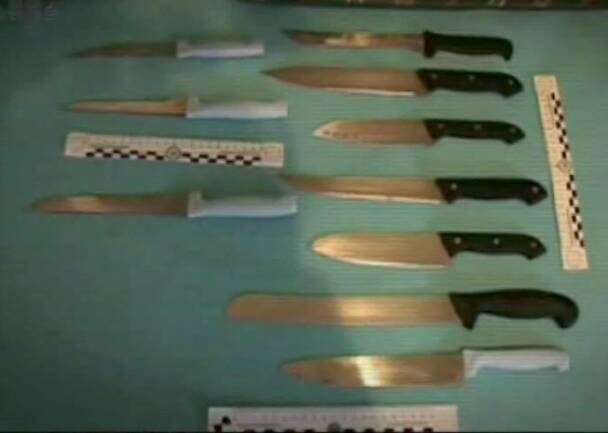
There were plenty of knives in the cottage. It would make no sense for Amanda and Raffaele to transport a knife from Raffaele's apartment to commit a murder.
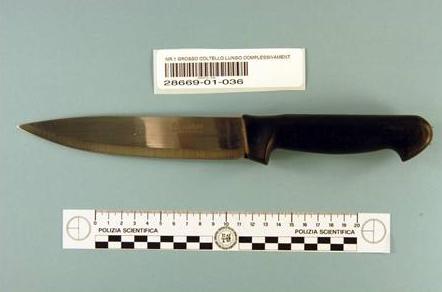
The blade of the knife is clearly to big to have inflicted the wounds on Meredith
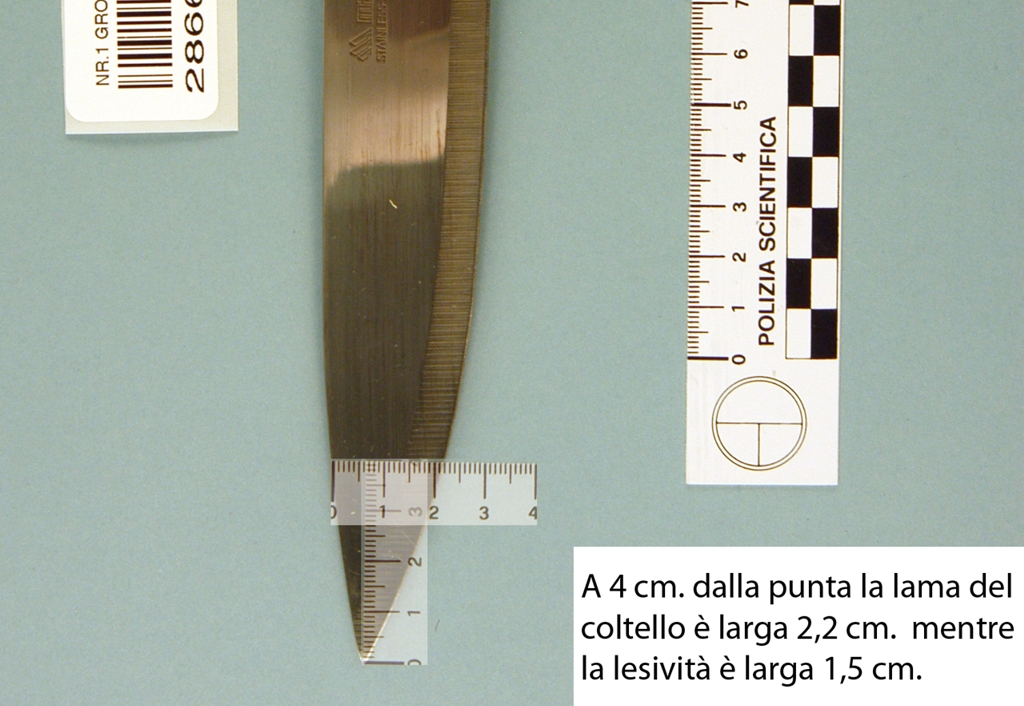
At 4 cm from the tip the knife blade is 2.2 cm wide, while the injury (i.e. the small wound) is 1.5 cm wide. Raffaele's kitchen knife could not have caused the wounds. The knife blade is also too long to have inflicted the large wound.
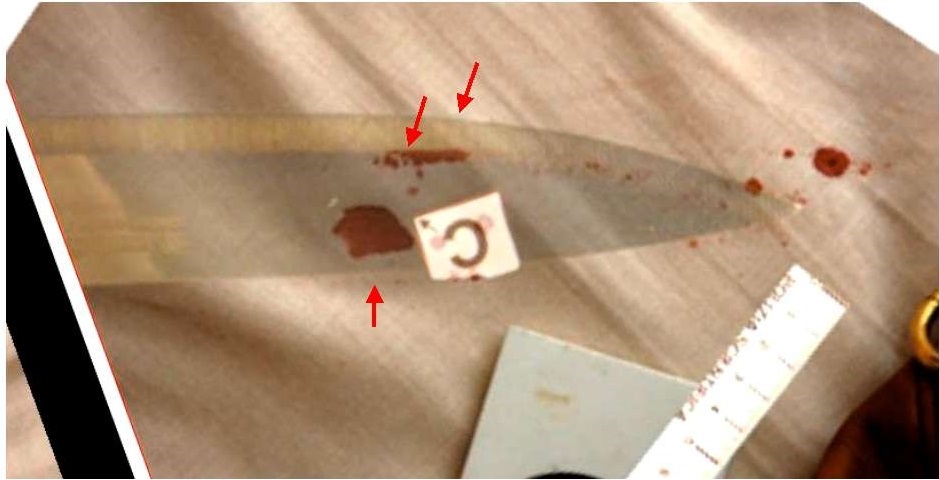
Raffaele Sollecito's forensics expert Francesco Vinci clearly showed that Raffaele's kitchen knife was to large to make the imprint on the bed. You can view Professor Vinci's entire report here.

